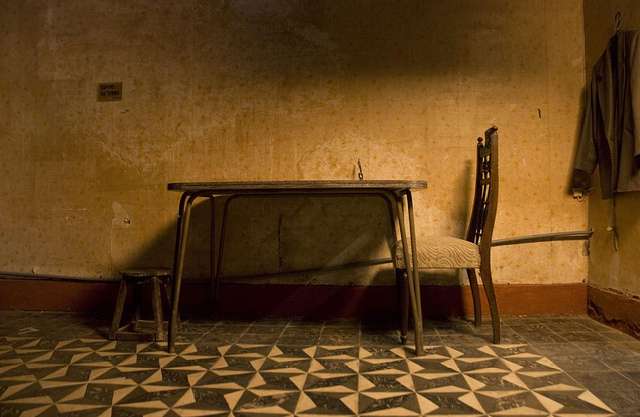-
Daniel and Diego Vega: Octubre (2010)
Daniel and Diego Vega: Octubre (2010)

CLEMENTE'S 'OFFICE' IN OCTUBRE: CLIENT'S SEAT ON THE LEFT, HIS ON THE RIGHT
A reluctant father in a month of miracles
In this fully realized if slow-to-charm debut, the Vega brothers take us into a world of Lima that seems initially as dark as Pablo Larraín's Seventies Buenos Aires. Their protagonist is almost as dry and inhuman as the characters played by Alfrado Castro in Larraín's successive films, Tony Manero and Post Mortem. But Octubre focuses on a month of miracles and forgiveness, a middle-aged lady who lights candles and bakes sweet pastries, and a found baby girl who is rescued and thrives. At the center of things is a ghetto money lender with a heart of granite, a hard black pompadour, and a tendency to get prostitutes pregnant. He is going to change, though unwillingly, and only a little.
The middle-aged Clemente (Bruno Odar) has the dignity of a fading peacock, and everyone knows him as "the pawnbroker's son," even if his father is long gone. He lends money at high interest, and his office is as bleak as, and part of, his rudimentary house. He is mean, and deeply trained so, but the worst he does if a client doesn't pay on time is break a window pane. There's nothing in his life otherwise, no real friends, and when someone breaks into his house and leaves a baby in a basket he receives this event with scant enthusiasm. But he keeps the girl, holding it like a rag doll while seeing clients. This can't last, obviously.
This is when Sofia (Gabriela Velasquez), a motherly spinster in the neighborhood, comes in. Clemente hires her to come over and take are of he baby. This is ostensibly to give Clemente time to go looking for the mother, which involves trying, with comic lack of success, to pass a forged banknote he took because "it" (the baby) distracted him, and visiting various prostitutes, and finally getting roughed up by a cabbie he's rude to. Meanwhile Sofia has moved in, and even winds up sleeping in Clemente's bed at times. She goes on baking cakes for the local deli and participating in lottery discussions and the week-long October religious procession -- the real one is filmed -- that is a feature of the month of October, the "purple" month of miracles -- in Lima. She names the baby "Milagros," miracle.
Bruno Udar, as Clemente, anchors the piece with his deadpan puss and dry line deliveries. Eventually though the film avoids either buffoonery or excessive sweetness, it shows Clemente turning into something more of a human being. The naturalness of Gabriela Velasquez is an important element too, and all the actors read as authentic, particularly a couple of the clients and Clemente's plump, glasses-wearing favorite prostitute, who qualifies almost as a friend. A running subplot is of an old man who is finagling to get his chronically ill girlfriend out of a hospital ward into his house. We get to see, briefly, plenty of Clemente's clients.
When I said this is slow-to-charm I meant it has not quite begun to charm me yet. For one thing Fergan Chavez-Ferrer's lighting is so dim and his cinematography is so cold (though composed with great precision) that the picture takes a long time to draw you in. The "happily ever after" consists of the fact that Clemente tries to throw Sofia out, but she stays. Ultimately his scant enthusiasm is, after all, still enthusiasm. The prayers to the Land of Miracles that are a feature of Octobers in Peru have had their effect. One French reviewer compared the protagonist to Ebenezer Scrooge, but his transformation is nothing like as dramatic as Scrooge's. It's almost invisible. He remains a character who's hard to like; but he has also failed to exhibit quite a Scrooge-like cruelty. The Vega brothers have kept their charm and sweetness tart, learning by their own admission their lessons from Kaurismäki, Jarmusch and Bresson. They've also mentioned Uruguayan director Juan Pablo Rebella's Whisky as a work they admire.
Octubre was featured at Cannes in the Un Certain Regard series, winning the President of the Jury Prize, and got three other nominations. It has since been in many festivals internationally. It was released in Paris December 10, 2010. Reviews were moderately good, public response less warm. Cahiers du Cinéma thought the brothers adhered too strictly to a fixed notion of what's auteurist, and I felt that too. Whether the Vega brothers themselves will emerge as distinctive stylists still remains to be seen, but their work as anointed by Cannes is guaranteed a place on the festival circuit. Seen and reviewed as part of the New Directors/New Films series, presented by MoMA and Lincoln Center from March 23 through April 4, 2011.
Octubre got a limited US theatrical release beginning May 6, 2011.
ND/NF screenings:
2011-04-02 | 9:00 PM | FSLC
2011-04-03 | 4:00 PM | MoMA
Last edited by Chris Knipp; 05-05-2011 at 10:20 AM.
 Posting Permissions
Posting Permissions
- You may not post new threads
- You may not post replies
- You may not post attachments
- You may not edit your posts
-
Forum Rules





 Reply With Quote
Reply With Quote
Bookmarks